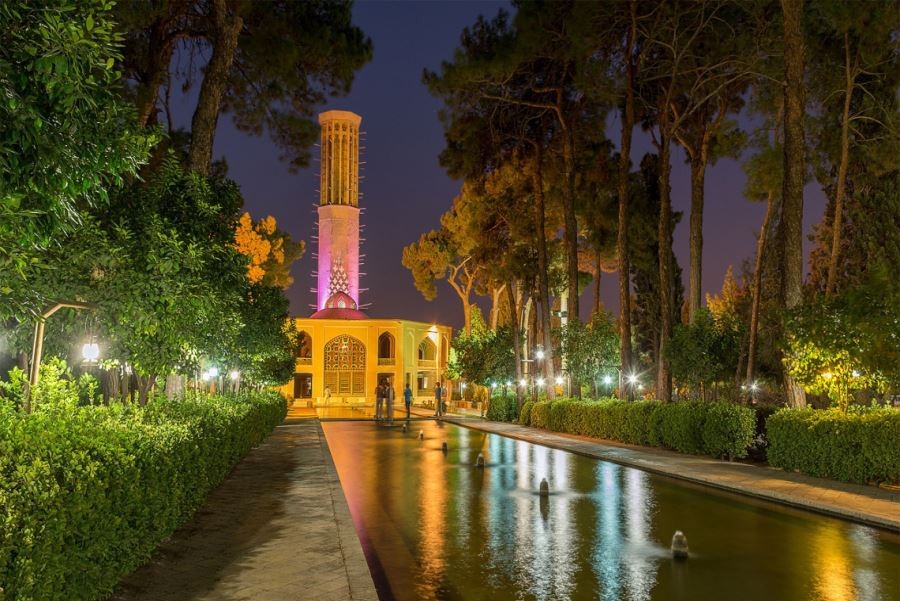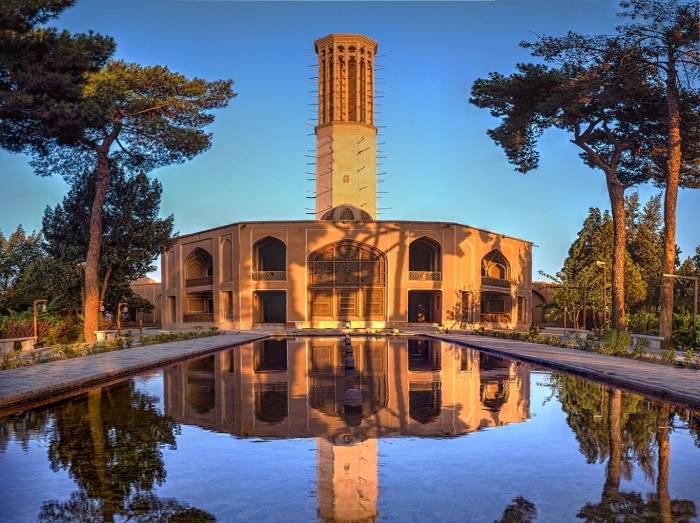
Location of Dolat Abad Garden
The main door to the garden opens in Shahid Rajaei Street and the other door in Dolat Abad Boulevard. You can also visit other nearby attractions in Yazd; Lari Ha House, Alexander’s Prison, and Amir Chakhmaq Complex are some of these. To name some other attractions, we can mention Zoroastrien’s Dakhmeh (Towers of silence), Rokn Addin Mausoleum, Markar Clock Tower, and Zoroastrian Fire Temple.
History of Dolat Abad Garden
Mohammad Taghi Khan Bafghi, the Yazd ruler at the end of the Afsharid era, established a garden as a residence for Shahrokh Mirza and Karim Khan Zand. The garden was known as a spectacularly complex and was called Dolat Abad Garden and is a priceless reminiscence of Afsharid and Zand Dynasties.
Back in time, there were too many tall and dense trees that could hide the garden from all those outside of it. It was also located in the suburban area of Yazd then but in the Qajar era, when the city was expanded, it became a part of the urban context. With further developments in the Pahlavi era, it was centered in the city, the same location as today.
Dolat Abad Garden was then changed into ruins for a while. From 1969 to 1985, Culture and Arts Ministry rented the garden and devoted it to an office with an aim to preserve the national heritage. Renovations and reconstructions were applied to the garden but it never got its former prosperity back.
Structure of Dolat Abad Garden
What is observed as the plot in Dolat Abad Garden is a pure sample of Persian or Iranian architecture. In the past, the garden was used for residential and governmental purposes. It used to include four main buildings inside that only three of them have survived within years. It consists of two rectangular parts of Andarooni (=inner part) and Birooni (=outer part). State gatherings, sports events, and governmental meetings were all held in the external garden and the internal garden was home to kings and important figures. It should also be mentioned that the two external and internal parts were constructed totally separately from each other and sometimes there were even some guardians defending the internal structure.
From a structural point of view, Dolat Abad Garden can be considered a garden-yard type and it is often affiliated with two gardens in Shiraz, Narenjestan Ghavam Garden, and Haft Tanan Garden. This association is due to their architecture that a garden is designed in the center surrounded by buildings and mansions.

• History
Dolat Abad Garden was built in the late Afsharid dynasty in 1160 AH by Mohammad Taqi Khan Bafaqi, known as (Khan the Great), who was the head of Yazd Khavanin dynasty. He first built a 5km long aqueduct that brought water from Mehriz to Yazd and the present garden, and then built his own government palace (Dar al-Hakumah). The garden, with an area of about 70,000 m², consisted of many buildings, ponds, and fountains, around which there were pomegranate and grape trees with many beautiful flowers which added beauty to the garden.
Dolat Abad Garden was the residence of current ruler and contemporary with Shahrokh Mirza and Karim Khan Zand. The monument that should have been owned by the descendants of Mohammad Taghi Khan was taken by the Cultural Heritage and is currently managed by Mohammad Ali Mo’ezaldini (son-in-law of the Wali Faqih agent).
• Location
Dolat Abad Garden was located outside of Yazd then but in Qajar era, when the city was expanded, it became a part of the urban area. With further developments in Pahlavi era, it was centered in the city, the same location as today.
• Architecture
From a structural point of view, Dolat Abad Garden can be considered a garden-yard type and it is often associated with two gardens in Shiraz, Narenjestan Ghavam Garden, and Haft Tanan Garden. This association is due to their architecture that a garden is designed in the center surrounded by buildings and mansions.
Dolat Abad Garden is divided into two parts: the Interior and the Exterior area.
In terms of functional typology, Dolat Abad Garden is a “Residential – governmental” garden.
In a way that the outer area was a site for State gatherings, sports events, and governmental meetings, and the inner area was a private and residential part of the complex. In the residential-governmental gardens, the inner realm was completely distinguished from other realms, and even a concierge or a guardian was appointed to oversee it.
– The Interior Section
This part was the residence of the ruler and his family and consisted of the following buildings:
• Vestibule Building (Hashti Pavillion= Hasht means eight in Persian)
• Harem
• Paradise (Behesht Aeen) – used in the cold months
• Kitchen
• Watchtower
• Private Cistern
• Summer and Winter Stalls
The Vestibule building;
The Vestibule building is one of the most important parts of the complex, combining the flow of air and water in the most beautiful way. In this building, by combining wind and water, which is flowing inside the building, cool air is transmitted from the wind catcher to the alcove and chambers. Therefore, it is also called the summer building. It consists of three alcoves with lattice doors and two chambers and the overall shape is octagonal. The ceiling of its middle section has a beautiful workmanship by Master Haji Ali Akbar Akhund, which is very skillfully executed with mud and plaster. There in a wind catcher on the vestibule that is considered to be the most significant symbol of Dolat-Abad garden. It has a height of 33.8 meters, the highest in the world.
The Watchtower;
Dolat Abad Garden is surrounded by a tall adobe wall with a watch tower
– The Exterior Section:
• Frontage (Jolo-Khan) and the Portal
• Mirror Hall
• Tehrani Mansion
• Two Markets
• Public Cistern
The most significant characteristic of the design of Dolat abad Garden is believed to be the attempt of the architect in selecting tactful angles for providing the best views and landscape.
